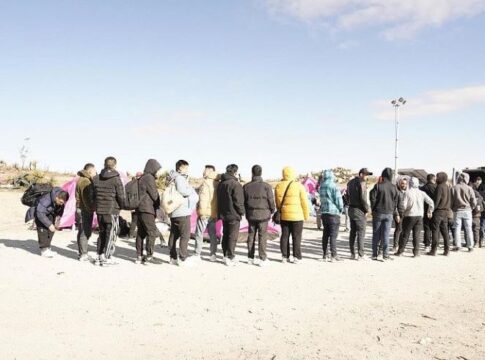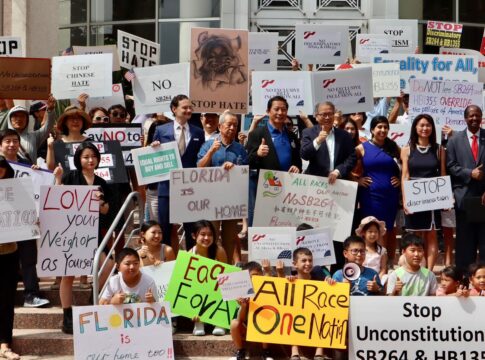By Amy-Xiaoshi DePaola
What does it mean to be Asian American?
Over 7,000 interviews with AAPI adults conducted by the Pew Research Center tried to answer this question.
The survey from the Center provided a deep dive into the AAPI perspective on the American dream, political leanings and identity.
The researchers conducted the survey in six languages–Chinese, English, Hindi, Korean, Tagalog and Vietnamese between July 5, 2022, to Jan. 27, 2023. It largely focuses on the five largest origin groups among AAPIs—Chinese, Filipino, Indian, Korean and Vietnamese—as well as Japanese. In fact, the definition of what it means to be “Asian” differed among groups, with most surveyed AAPI adults considering East, Southeast and South Asians as “Asian” but divisive on whether Central Asians, such as those from Afghanistan, are Asian.
LATEST STORIES
1 in 5 AAPI adults stated that they have hidden part of their heritage—such as food, cultural practices and clothing—from others. Younger adults, ages 18 to 29, reported they were more likely to do that, as opposed to older AAPIs (65 and up), citing fears of embarrassment, being teased and/or facing discrimination.
For those who grew up in predominantly Asian areas, like Vivi, who also wished to not disclose her last name, those experiences have been mostly absent.
“In elementary school, almost all my friends were AAPI, so we were all eating rice at lunch and had a very similar lived experience,” said Vivi, who grew up in Torrance and Garden Grove. She currently is a graduate student at the University of California, Irvine.
“It’s eye-opening when I go to other places with a small Asian population,” she said.
But others aren’t as fortunate in being surrounded by a community: A third of AAPIs had reported changing their daily routines as a result of anti-AAPI violence in 2022, even in small ways, including Vivian, a museum staffer, who also asked that her last name not be used.
“The closest we got to doing or changing anything about ourselves was my mom and I telling my sisters to say they’re Viet or just Californian if anyone dared to ask them what they are,” Vivian recounted.
Though she said that no one ate or dressed differently, she recalled that they “stopped talking in Cantonese in public for a while.”
Law enforcement officer Giang Thành Lê said for him, it goes further.
“I don’t play Asian music; I tend to pack more western-style food for lunch. Less questions, less judgment,” Lê said, citing fear of pushback from his predominantly “white or Hispanic coworkers” about his Vietnamese heritage.
It’s not just him, he added.
“Most of my AAPI friends and family are responding in similar ways,” Lê explained. “Some are going out of their way to hide or change. … Others, if they live in a predominantly minority community will try to stay in the boundaries of that community. If only staying put would guarantee your safety. … We are always targets, and we have no one to trust but ourselves.”
Vivian’s and Lê’s responses are in line with another finding in the Center’s report: Over half of the AAPI adults surveyed stated that “what happens to Asians in the U.S. affects their own lives.”
But while 6 in 10 AAPIs said that they’re perceived as just “Asian” by most people, ethnic roots play a key role in connecting AAPIs, according to the report. Over half of the AAPIs surveyed said that they use their specific country of origin to identify themselves, often with the addition of “American” (i.e., Korean American, Filipino American, etc.), and very few describe themselves as simply “Asian.” A shared country of origin was a key factor in shaping friendships among AAPIs in the U.S., the report said.
But what stood out to Neil G. Ruiz, the Center’s Head of New Research Initiatives, was how closely the definition of what it means to be “American” aligned between the AAPI and the general U.S. population of adults.
Over 90% of both groups, for instance, agreed that individual freedoms, respect of American political institutions and laws, and accepting those of differing identities are key to being “truly American.” Both also agreed that the fundamental components of the American dream include owning a home, retiring comfortably and having freedom of choice.
Additionally, with the exception of Japanese adults, about a quarter of AAPIs say the American dream is out of reach.
“We know demographically that Japanese Americans are majority native-born,” Ruiz said during a press call.
He explained that those who lived in the U.S. much longer—as opposed to the “newly minted” residents—were more likely to say that they were on their way to achieving the American dream, according to the data. Likewise, Japanese adults were the least likely among AAPI populations to say most or all of their friend groups were Asian.
With the rise of AAPI hate, two-thirds majority of adults surveyed reported that it is “extremely” important to have a national leader advocating for the community. However, although most AAPI registered voters tend to lean Democratic or liberal—it depends on the country of origin. About half of the Vietnamese American voters support the Republican Party, according to the report.
It’s a stark contrast to, for example, “two-thirds of the Indian population” who were registered as or supported Democrats, Ruiz said.
As of 2020, the majority of AAPI voters live in five states, with California containing nearly one-third of the U.S. Asian electorate. (New York, Texas, Hawaii and New Jersey follow California in eligible AAPI voters.)
In addition to being the fastest-growing group of eligible voters over the past twenty years, the community was recorded as the fastest-growing racial and ethnic group and constitutes 7% of the U.S. population, according to the 2021 American Community Survey. Of the AAPI population, 68% adults are immigrants, while 25% were born in the U.S. to immigrant parents, according to a Pew Research Center analysis of the 2022 Current Population Survey.
In conducting this report, the Pew Research Center’s classification of AAPIs was “close to the Census Bureau’s definitions,” said Mark Lopez, the Center’s Director of Race and Ethnicity Research.
However, while this particular survey focused on the majority AAPI ethnic groups, Ruiz said that it is “just the beginning” of the Center’s reports on AAPIs, adding that the Center is hoping to explore more insights into Pacific Islanders.
As opposed to the average AAPI immigrant experience, Ruiz said, it’s a “story of America coming to them,” providing a unique and often untold perspective.
You can read the full report and conclusions on the Pew Research Center’s website here.
AsAmNews is published by the non-profit, Asian American Media Inc. Follow us on Facebook, X, Instagram, TikTok and YouTube. Please consider making a tax-deductible donation to support our efforts to produce diverse content about the AAPI communities. We are supported in part by funding provided by the State of California, administered by the California State Library in partnership with the California Department of Social Services and the California Commission on Asian and Pacific Islander American Affairs as part of the Stop the Hate program. To report a hate incident or hate crime and get support, go to CA vs Hate.









